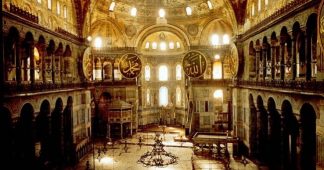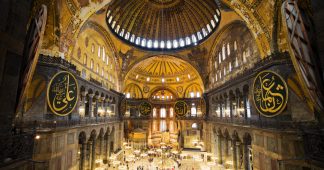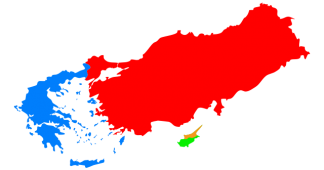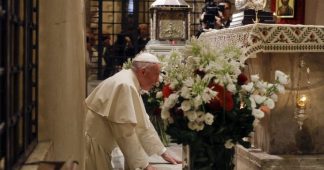By
The Turkish newspaper Hurriyet has reported that the Hagia Sofia “Mosque” in Edirne is being restored, and it will be completed by the Islamic month of Ramadan that falls this year between 23 April and 23 May. This church was converted from church to mosque during the Ottoman era. The magnificent building was damaged during the earthquake of 1965, and it has been closed since then.
Adrianopolis – Edirne
Like other cities in Thrace and Asia Minor, Edirne is an historic Greek city. Its predecessor was Uskudama or Orestias, an ancient Greek hamlet, which “may have existed since the dawn of civilization,” according to the Southern Europe: International Dictionary of Historic Places.
The Roman emperor Hadrian (117-138 CE) enlarged, developed, and fortified the hamlet into a city, and renamed it to Hadrianopolis, which would then be used as Adrianopolis, after himself in the second century. It became part of the Eastern Roman (Byzantine) Empire after the division of Roman Empire in 395. “So thoroughly Greco-Roman was its identity that the city adopted the name Hadrianopolis (the Greek rather than Latin name for ‘City of Hadrian’) in honor of its patron,” adds the Southern Europe: International Dictionary of Historic Places.
The Ottomans captured Adrianopolis, a major Byzantine city in Thrace, in the fourteenth century and made it the Ottoman capital until they took Constantinople in 1453.
“Capturing the city in 1362, the victorious Turks promptly renamed it Edirne, and quickly turned the leading churches into mosques, whitewashing the interiors to conceal the images so offensive to their Moslem faith…. The Turkish rule was painful for Christians, who labored under many restrictions… [T]he native Christian population rapidly converted to Islam, making those who remained Christians a distinct and diminutive minority within the city and region of Edirne.”
There are no longer Greek Christian congregants in the once majority-Christian city of Adrianopolis because the remaining Christian believers in the region were either killed or deported during the 1913-1923 genocide.
Edirne is in eastern Thrace, where, according to genocide scholars, the Greek genocide commenced prior to the First World War. The decision to eliminate Christians was made by the political party in power in the Ottoman Empire, the Committee of Union and Progress (CUP), popularly known as the Young Turks.
Historian Dr. Vasileios Th. Meichanetsidis writes in his article “The Genocide of the Greeks of the Ottoman Empire, 1913–1923: A Comprehensive Overview” that “Following the 1908 revolution, a ‘programme of Ottomanization’ began to be applied in Thessalonica. Initially, this program aimed at the elimination of the Christian notables in Macedonia. Later, after the Balkan Wars [of 1912–1913], it was extended to Eastern Thrace and western Asia Minor (Ionia)…
“In this framework of extreme nationalism and under the cover of the imminent war, the CUP began to implement its plan of demographic homogenization and Turkification. Initially, this process began in the western part of the empire, in the region of Eastern Thrace, and was later expanded to include all of Asia Minor.”
Regarding the atrocities during that period, Harry Stürmer, correspondent of the Kölnische Zeitung in Constantinople (1915–1916), said, in part:
“I should like to say a word here about these Greek persecutions in Thrace and Western Anatolia that have become notorious throughout the whole of Europe. They took place just before the outbreak of war, and cost thousands of peaceful Greeks—men, women and children—their lives, and reduced to ashes dozens of flourishing villages and towns.”
The Greek Genocide Resource Center also details the persecution of the Greeks of Eastern Thrace: “The methods used to eliminate Greeks in the region included: boycotting businesses, looting, murders, deportation, extortion and the pillaging of towns, villages and places of worship. The methods were so effective and were met with such little or no resistance and international condemnation, that similar methods were later used against other Greeks and other minorities in the Empire to bring about their destruction.”
The annihilationist campaign that targeted all Christians including Greeks, Assyrians and Armenians was a jihad genocide — on November 14, 1914, in Constantinople, capital of the Ottoman Empire, the religious leader Sheikh-ul-Islam declared an Islamic holy war on behalf of the Ottoman government.
Historian Tigran Matosyan notes that during the Genocide, “the Young Turks hearkened back to the concept of Holy War. By declaring jihad in November, 1914, the Turkish government intended to channel Muslim religious sentiments not only against the Christian powers but also against the ‘disloyal infidels’ within the Ottoman state. To understand how successful this propaganda technique was in 1915-1916, one should turn to survivor accounts and memoirs that describe the Turkish and Kurdish mobs attacking Armenian caravans with shouts and cries of ‘Allah’ and ‘jihad’.”
From Hagia Sophia Church in Ainos, Adrianopolis
To “Ayasofya Mosque” in Enez, Edirne
One of the many churches converted into mosques during the Ottoman rule in the region was the Hagia Sophia church in Ainos, (Enez in Turkish) which is today inside Edirne’s borders.
The ancient town of Ainos or Aenus is of great significance for Christianity. It was an episcopal see in the 4th century — St. Olympius was then the bishop of the town.
Ainos remained a residential see of the Greek Orthodox Church until the 1923 forcible population exchange between Greece and Turkey and is now a titular metropolis. The town is listed by the Catholic Church as a titular see or a “dead diocese”.
Hande Günözü, a researcher of the history of Turkish art, writes that Ainos Hagia Sophia Church is thought to have been constructed in the 12th century. “The church possibly served as a cathedral in Ainos and is also believed to be larger than almost all churches in Constantinople dating back to the middle and late Byzantine era. Having an atypical design, the church could be called a basilica with a dome. It was converted into a mosque and named after the Ottoman sultan [Mehmed Mohammed] as the ‘Fatih [Conqueror] Mosque’ in 1455.”
The restoration works to reconvert the former church into a mosque have been ongoing for years. The Turkish newspaper Radikal reported in 2015:
“One more Hagia Sophia Church in Turkey is being turned into a mosque. After the Hagia Sophias in Trabzon [Trebizond] and Iznik [Nicaea] were turned from museums to mosques, the Hagia Sophia in the Enez town in Edirne is also being turned into a mosque now. The General Directorate of Foundations declared that the Hagia Sophia in Enez would be turned into a mosque though it was previously claimed that it would become a museum. One of the symbols of the region, the church has been restored since 2007. It is situated on the highest peak on southeast edge of the Enez hill. The structure, which has the design of a Greek cross, is among the greatest churches of its time.”
There is no shortage of mosques in any part of Turkey including Edirne. On the contrary, what is missing from the city is its historic churches. Except for the two Bulgarian churches that were renovated in 2000s after long years of “abandonment” — the Church of Sts. Constantine and Helen and St. George Church — there are no other active churches in the city.
So why is Turkey constantly converting historic churches into mosques? Historian Dr. Alexandros K. Kyrou explains the mentality behind the conversion of Constantinople’s historic Hagia Sophia Cathedral into a mosque by the Ottomans:
“Indeed, the purpose for the construction of the massive minarets that now tower over Hagia Sophia was to project to the world Islam’s triumph over Christendom’s greatest empire, city, and church. The capture of Hagia Sophia confirmed and symbolized in the Ottomans’ imagination their belief in the superiority of their state and faith over all other nations and all religions, a putative affirmation of their providential role and destiny in history.”
The conversion of non-Muslim places of worship into mosques in an attempt to demonstrate the “supremacy” of Islam towards non-Muslim faiths has been a widespread occurrence since Islam’s inception in the seventh century. Not only many churches, but also synagogues, Hindu, Buddhist, Yazidi and Zoroastrian and other non-Muslim temples have either been converted into mosques or destroyed during and in the aftermath of the Islamic invasions.
Yet, Turkey still continues this tradition while striving for membership in the European Union (EU). Turkey became a member of the Council of Europe in 1949, signed a Customs Union agreement with the EU in 1995 and was officially recognized as a candidate for full membership in 1999. Turkey also became a NATO member in 1950.
Turkey’s current population is around 80 million and the population of Germany, EU’s currently most populous country, is around 82 million. Given the birth rates of both countries, it seems that Turkey is likely to surpass Germany soon. Hence, if Turkey joins the EU, it will be the most or second-most populous nation in the Union and occupy the first- or second-largest number of seats in the European Parliament.
Given Turkey’s historic hostility towards Judeo-Christian civilization, how would Turkey’s EU membership affect the future of Europe? Anyone who cannot answer this question should just have a look at the Hagia Sophia or the Conqueror (Fatih) “mosque” in Edirne and all other historic Anatolian churches and synagogues that are in ruins now.
Published at https://www.jihadwatch.org/2020/02/turkey-converts-yet-another-ancient-greek-church-into-a-mosque











